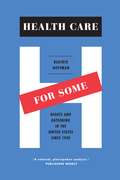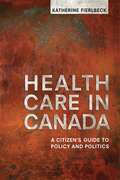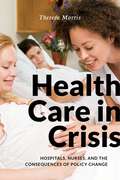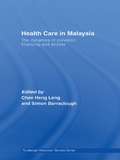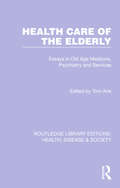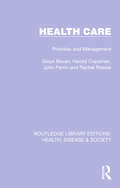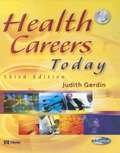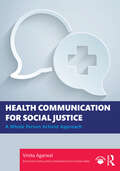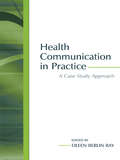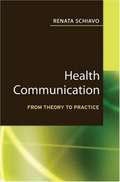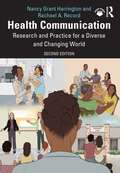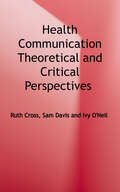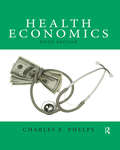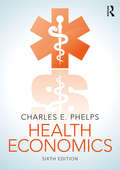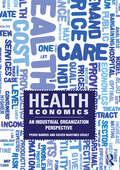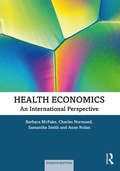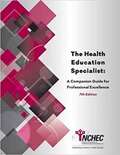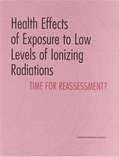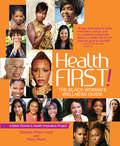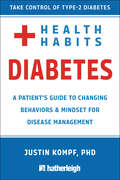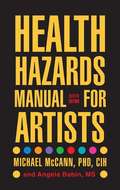- Table View
- List View
Health Care for Some: Rights and Rationing in the United States Since 1930
by Beatrix HoffmanIn Health Care for Some, Beatrix Hoffman offers an engaging and in-depth look at America's long tradition of unequal access to health care. She argues that two main features have characterized the US health system: a refusal to adopt a right to care and a particularly American approach to the rationing of care. Health Care for Some shows that the haphazard way the US system allocates medical services--using income, race, region, insurance coverage, and many other factors--is a disorganized, illogical, and powerful form of rationing. And unlike rationing in most countries, which is intended to keep costs down, rationing in the United States has actually led to increased costs, resulting in the most expensive health care system in the world. While most histories of US health care emphasize failed policy reforms, Health Care for Some looks at the system from the ground up in order to examine how rationing is experienced by ordinary Americans and how experiences of rationing have led to claims for a right to health care. By taking this approach, Hoffman puts a much-needed human face on a topic that is too often dominated by talking heads.
Health Care in Canada
by Katherine FierlbeckHealth Care in Canada examines the challenges faced by the Canadian health care system, a subject of much public debate. In this book Katherine Fierlbeck provides an in-depth discussion of how health care decisions are shaped by politics and why there is so much disagreement over how to fix the system.Many Canadians point to health care as a source of national pride; others are highly critical of the system's shortcomings and call for major reform. Yet meaningful debate cannot occur without an understanding of how the system actually operates. In this overview, Fierlbeck outlines the basic framework of the health care system with reference to specific areas such as administration and governance, public health, human resources, drugs and drug policy, and mental health. She also discusses alternative models in other countries such as Britain, the United States, and France. As health care becomes increasingly complex, it is crucial that Canadians have a solid grasp of the main issues within both the policy and political environments. With its balanced and accessible assessment of the main political and theoretical debates, Health Care in Canada is an essential guide for anyone with a stake in Canada's health system.
Health Care in Crisis: Hospitals, Nurses, and the Consequences of Policy Change
by Theresa MorrisAn inside look into how hospitals, nurses, and patients are faring under the Affordable Care Act More and more not-for-profit hospitals are becoming financially unstable and being acquired by large hospital systems. The effects range from not having necessary life-saving equipment to losing the most experienced nurses to better jobs at other hospitals. In Health Care in Crisis, Theresa Morris takes an in-depth look at how this unintended consequence of the Affordable Care Act plays out in a non-profit hospital’s obstetrical ward. Based on ethnographic observations of and in-depth interviews with obstetrical nurses and hospital administrators at a community, not-for-profit hospital in New England, Health Care in Crisis examines how nurses’ care of patients changed over the three-year period in which the Affordable Care Act was implemented, state Medicaid funds to hospitals were slashed, and hospitals were being acquired by a for-profit hospital system. Morris explains how the tumultuous political-economic changes have challenged obstetrical nurses, who are at the front lines of providing care for women during labor and birth. In the context of a new environment where hospital reimbursements are tied to performance, nursing has come under much scrutiny as documentation of births—already laboriously high—has reached even greater levels. Providing patient-centered care is an organizational challenge that nurses struggle to master in this context. Some nurses become bogged down by new processes and bureaucratic procedures, while others focus on buffering patients from the effects of these changes with little success. Morris maintains that what is most important in delivering quality care to patients is the amount of interaction time spent with patients, yet finding that time is a real challenge in this new environment. As questions and policies regarding health care are changing rapidly, Health Care in Crisis tells an important story of how these changes affect nurses’ ability to care for their patients.
Health Care in Malaysia: The Dynamics of Provision, Financing and Access (Routledge Malaysian Studies Series #Vol. 4)
by Chee Heng Leng Simon BarracloughThe health care system in Malaysia has undergone a fundamental transformation over the last two decades. This book examines this transformation and explores the pressing issues it faces today. It includes coverage of: the evolution of the system since independence, from the colonial legacy of national provision bequeathed from the British to the impact of the global ideological shift against statism in the 1980s considers the responses of the Malaysian state and government policy issues such as equity of provision, women's access to health care, HIV-AIDS health care, care for the elderly. The book offers a detailed examination of the changing face of health care in Malaysia, and its impact on Malaysian citizens, users and society.
Health Care of the Elderly: Essays in Old Age Medicine, Psychiatry and Services (Routledge Library Editions: Health, Disease and Society #1)
by Tom ArieOriginally published in 1981 and edited by a pioneer in psychogeriatric services, this book spans medicine, psychiatry, social work and organisation of services of the elderly, written by eminent authors from several different professions. Chapters include those on stroke rehabilitation, dementia, neurosis, psychotherapy for the elderly and institutional care, among others. The book discusses many issues which remain as pertinent today as when it was first published, not least the problems of providing health services for ageing populations.
Health Care: Priorities and Management (Routledge Library Editions: Health, Disease and Society #4)
by Gwyn Bevan Harold Copeman John Perrin Rachel RosserOriginally published in 1980, this book explores how the NHS confronts perennial stresses and problems, considering in particular the allocation of the scarce resources within the health service. Written by distinguished academics, three of whom previously undertook research work for the Royal Commission on the NHS, the discussion centres on whether more could not be spent, whether resources are being allocated equitably, how planning can work most effectively, whether there are feasible ways of financing the service and how organisation and management could be improved: in short, all issues which continue to be pertinent to the NHS today.
Health Careers Today (3rd Edition)
by Judith GerdinThis valuable guide provides an introduction to the basic health care environment and a preview of various popular health careers designed to help students make informed choices based on their interest and their commitment to the educational and professional responsibilities of each health career. It gives students a realistic glimpse of various health careers available today, outlining the roles and responsibilities, levels of education and credentialing, daily functions, and key disorders and assessment tools that are involved.
Health Communication for Social Justice: A Whole Person Activist Approach (Routledge Social Justice Communication Activism Series)
by Vinita AgarwalThis textbook combines whole person and social justice perspectives to educate students on the role of communication in promoting inclusive and person-centered healthcare practices. This book explores health inequities experienced by disadvantaged and marginalized populations and outlines the actions students can take to address these challenges. The book demonstrates how physical, mental, and emotional health is connected to equitable understandings of individual, community, and environmental health. It considers how social, interpersonal, and systemic factors such as personal relationships, language, literacy, religion, technology, and the environment affect health equity. To present strategies and invite action to support the goals of the whole person, social justice activist approach, the book provides contemporary examples, interviews with communication scholars, and case studies that examine local communities and the everyday contexts of health meaning making. This textbook serves as a core or supplemental text for graduate and upper-level undergraduate courses in health communication. Online resources include PowerPoint slides and an instructor manual containing sample syllabi, assignments, and test questions. They are available online at www.routledge.com/9781032081038.
Health Communication in Practice: A Case Study Approach (Routledge Communication Series)
by Eileen Berlin RayHealth Communication in Practice: A Case Study Approach offers a comprehensive examination of the complex nature of health-related communication. This text contains detailed case studies that demonstrate in-depth applications of communication theory in real-life situations.With chapters written by medical practitioners as well as communication scholars, the cases included herein cover a variety of topics, populations, contexts and issues in health communication, including:*provider-recipient communication and its importance to subsequent diagnosis and treatment;*decision-making;*social identity, particularly how people redefine and renegotiate their social identity;*communication dynamics within families and with health care providers through unexpected health situations;*delivery of health care; and*health campaigns designed to disseminate health-related information and change behaviors.Reflecting the changes in health communication scholarship and education over the past decade, chapters also explore current topics such as delivering bad news, genetic testing, intercultural communication, grieving families, and international health campaigns. A list of relevant concepts and definitions is included at the end of each case to help students make connections between the scenario and the communication theories it reflects.With its breadth of coverage and applied, practical approach, this timely and insightful text will serve as required reading in courses addressing the application of communication theory in a health-related context.
Health Communication: From Theory to Practice
by Renata Schiavo"Health Communication: From Theory to Practice" is a much needed resource for the fast-growing field of health communication. It combines a comprehensive introduction to current issues, theories, and special topics in health communication with a hands-on guide to program development and implementation. While the book is designed for students, professionals and organizations with no significant field experience, it also includes advanced topics for health communication practitioners, public health experts, researchers, and health care providers with an interest in this field.
Health Communication: Research and Practice for a Diverse and Changing World
by Nancy Grant Harrington Rachael A. RecordThis thoroughly revised second edition covers the major areas of research, theory, and practical application in health communication. This textbook takes an in-depth approach to health communication by analyzing and critically evaluating research conducted across multiple paradigmatic perspectives and focusing on translational application of research findings. Using the story of the Montgomery family, a biracial, multigenerational family, and their health experiences as a case study, chapters explore topics including patient–provider communication, health communication in the media, ethical issues, and public health crises. New chapters cover the potential for communication to address discrimination in healthcare settings, health information seeking, social support and caregiving, and the relationship between health and environmental communication. Chapters offer pedagogical features that will prove useful to students and instructors of health communication, such as summary boxes, theory tables, suggestions for in-class activities, discussion questions, and lists of additional resources. Developed for use in advanced undergraduate and master’s level health communication and public health courses, this text represents the breadth and depth of health communication theory and research as it exists today. Online resources for instructors including additional theory tables, PowerPoint slides, test questions and assignments, sample syllabi, and lists of additional resources are available at https://www.routledge.com/9781032100470.
Health Communication: Theoretical and Critical Perspectives
by Ruth Cross Ivy O'Neil Sam DavisHealth communication is key to promoting good population and individual health outcomes. As the field has developed, there is a growing need for a critical appraisal of the ideologies and theories underpinning health communication in order to ensure effective practice. This book clearly situates health communication within its social context. It provides a critical overview of three key disciplinary areas - education, psychology and communication. Drawing on international examples throughout, the book challenges the underlying assumptions that drive the design and delivery of health promotion interventions. The authors argue that health communication is inherently political and pay close attention to issues of power, ethics and inequality throughout the text. This book will be valuable for those students at all levels who require a critical perspective, as well as practitioners in health communication and health promotion. With reference to detailed examples and annotated suggestions for further reading, the book is an accessible resource for analysing contemporary health communication.
Health Economics
by Charles E. PhelpsHealth Economics combines current economic theory, recent research, and health policy problems into a comprehensive overview of the field. This thorough update of a classic and widely used text follows author Charles E. Phelps' thirteen years of service as Provost of the University of Rochester. Accessible and intuitive, early chapters use recent empirical studies to develop essential methodological foundations. Later chapters build on these core concepts to focus on key policy areas, such as the structure and effects of Medicare reform, insurance plans, and new technologies in the health care community. This edition contains revised and updated data tables and contains information throughout the text on the latest changes that were made to the Patient Protection and Affordable Care Act (PPACA).
Health Economics
by Charles E. PhelpsCan we really use economic thinking to understand our health care system? Health Economics, now in its sixth edition, not only shows how this is done, but also provides the tools to analyze the economic behavior of patients and providers in health care markets. Health Economics combines current economic theory, recent research, and up-to-date empirical studies into a comprehensive overview of the field. Key changes to this edition include: additional discussion of the consequences of the Patient Protection and Affordable Care Act (PPACA), in light of current political changes; an extensive discussion of quality measures; more discussion of preventive services; a new section on drug markets and regulation; discussion of Accountable Care Organizations (ACOs); new references, problem sets, and an updated companion website with lecture slides. Designed for use in upper-division undergraduate economics studies, the book is suitable for students and lecturers in health economics, microeconomics, public health policy and practice, and health and society. It is also accessible to professional students in programs such as public policy, public health, business, and law.
Health Economics: An Industrial Organization Perspective
by Xavier Martinez-Giralt Pedro BarrosResearch in Health Economics has developed into a separate discipline for the last 25 years. All this intense research activity, has translated in the inclusion of courses of health economics, mostly at graduate level. However, the Industrial Organization aspects of the health care market do not occupy a central place in those courses. We propose a textbook of health economics whose distinguishing feature is the analysis of the health care market from an Industrial Organization perspective. This textbook will provide teachers and students with a reference to study the market structure aspects of the health care sector. The book is structured in three parts. The first part will present the basic principles of economics. It will bring all readers to the required level of knowledge to follow subsequent parts. Part II will review the main concepts of health economics. The third part will contain the core of the book. It will present the industrial organization analysis of the health care market, based on our own research.
Health Economics: An International Perspective
by Samantha Smith Charles Normand Barbara McPake Anne NolanHealth Economics: An International Perspective is the only textbook to provide a truly international, comparative treatment of health economics. Offering an analysis of health systems across borders, the fourth edition of this key text has been updated and revised to take account of changes in a host of countries. This edition features an expanded introduction, providing better grounding for many of the examples that come in subsequent chapters and making it easier for non-health care experts to see the links between the theory, the examples and the health care system components. It also boasts a restructured format, dividing the book into two broad sections: the first focuses on ideas and principles, along with evidence on their applications in the health sector, whereas the second focuses on introducing core tools and techniques used in applied health economics research. Further updates to this edition include: two new chapters on applied econometrics; a new chapter on equity, focusing on equity in access to health care, paying particular attention to how access and need for health care are defined and measured in applied research; a new chapter on emerging issues for health systems that are emanating from a series of global transitions both within (e.g. demographic change, epidemiological change, the global resolution on universal health coverage) and without the health sector (e.g. economic transitions). Throughout the text, examples and illustrations are taken from a wide range of settings and world regions, providing a unique overview of the performance of different health systems.
Health Education Specialist: A Companion Guide for Professional Excellence
by National Commission for Health Education CredentialingTHE HEALTH EDUCATION SPECIALIST: A COMPANION GUIDE FOR PROFESSIONAL EXCELLENCE SEVENTH EDITION
Health Effects of Exposure to Low Levels of Ionizing Radiations: Time for Reassessment?
by Committee on Health Effects of Exposure to Low Levels of Ionizing RadiationsInformation on the Health Effects of Exposure to Low Levels of Ionizing Radiations
Health First!: The Black Woman's Wellness Guide
by Hilary Beard Eleanor Hinton HoyttThe story of Black women in America is one of triumph and grace, even with odds stacked high against them. Health First! The Black Woman’s Wellness Guide provides you with a comprehensive guide to your #1 resource: yourself. Today, as Black women face an unprecedented health crisis, denial and self-neglect are no longer viable options. This groundbreaking volume is rooted in the pioneering work of the Black Women’s Health Imperative, the nation’s only nonprofit organization devoted to advancing the health and wellness of Black women and girls. It offers a core health philosophy—too long denied Black women—based on putting your health first. Health First! explores Black women’s most critical health challenges, connecting the dots through honest discussions with experts and the uncensored stories of real women—from adolescence through elderhood. The focus is on prevention and awareness, across generations and circumstances—from candid conversations about reproductive health and HIV/AIDS to frank explorations of Black women’s Top 10 Health Risks, including cancer, obesity, and violence. No matter what your age or health status, this unprecedented health reference will become a trusted ally as you seek accessible and relevant information to help you navigate your most pressing health needs. In an age of uncertainty, it’s time to take control and truly discover the vitality, power, and joy that can be yours when you learn how to put your health first.
Health For Christian Schools
by Anna Turner David RhodesProvide your junior-high (Health Level I) or senior high (Health Level II) with an understanding of the basic needs of the human body. Help him learn to promote his health physically, emotionally, intellectually, socially, includes the additional notes and activities required to teach Level II Health. The student text covers a variety of topics including nutrition, exercise, personal hygiene, safety, and disease.
Health For Life
by Charles B. Corbin Julius B. Richmond Elenore T. PoundsJulius, Elenore and Charles explore on ways to make every reader feel good, look good and most of all, have total lifestyle changes by living a healthy life. It has a total of 10 chapters, conducting an in-depth study as: Chapter 1 Learning About Yourself Chapter 2 Growing and Changing Chapter 3 Choosing Foods for Good Health Chapter 4 Becoming Physically Fit Chapter 5 Safety and First Aid Chapter 6 Drugs: What They Are and What They Do Chapter 7 Fighting Against Disease Chapter 8 Daily Care for Good Health Chapter 9 Your Decisions as a Health Consumer Chapter 10 Working for a Healthy Community
Health For Life
by Charles B. Corbin Julius B. Richmond Elenore T. PoundsLearn more about the decisions you can make every day to make your life healthy and happy.
Health Habits for Diabetes: A Patient's Guide to Changing Behaviors & Mindset for Managing Type 2 Diabetes
by Justin KompfA patient's guide to identifying and executing easy strategies and positive behaviors to help better manage their Type 2 diabetes. Health Habits for Diabetes highlights how to take the motivation to change from their diagnosis, use willpower, examine their sources of influence, form habits, and form a new integrated identity around healthy behaviors. Health Habits for Diabetes provides a what, why, and how for each stage of health behavior change including medication compliance, physical activity, mindset and nutrition. Most of the things that make us sick are preventable. They are preventable because they are the result of our behaviors. Using examples from research and practice, Health Habits for Diabetes uses this behavioral focus to help patients manage their Type 2 diabetes.
Health Hazards Manual for Artists
by Michael Mccann Angela BabinThis is the trusted resource for working artists and art students written by the leading authority on health hazards. Whether you work in painting, photography, sculpture, ceramics, printmaking, woodworking, textiles, computer, or children s art, this is the only reference book that covers all the dangers associated with metals, minerals, and chemicals. This first aid book shows how to treat injuries and work with proper caution while still being creative. Updates include new ventilation, photo processing, and computer systems. Whether you are a beginner or professional, this is a must for every school, art studio, and home.
